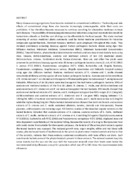| dc.description.abstract | Many disease-causing organisms have become resistant to conventional antibiotics. The toxicity
and side effects of conventional drugs have also become increasingly unmanageable, while their
costs are prohibitive. It has therefore become necessary to continue searching for alternative
medicines to treat such diseases. The possibility of developing pharmaceutical industries using
local raw materials should be looked into critically so that the cost of drugs can be affordable to
the local people. This study involved screening of various medicinal plants commonly used by
herbal medicine practitioners for bioactive compounds against bacteria. Standard bioassay
methods were employed throughout this study. They included preliminary screening bioassay
against human pathogenic bacteria strains using Agar Disc Diffusion method, Minimum
Inhibitory Concentration (MICs), Minimum Bactericidal Concentration (MBCs), Time kill
kinetics, phytochemical determination methods and one dose in vivo toxicity tests using mice.
Hexane, dichloromethane, acetone and methanol extracts of ten (10) medicinal plants:
Dichrostachyus. cinerea, Combretum molle, Euclea divinorum, Ficus sur, and other five plants
were screened by preliminary bioassay against nine (9) human pathogenic bacteria strains (E.
coli, ATCC 25922 S. aureus ATCC 85923, Pseudomonas aeruginosa NCTC 10662,
Escherichia coli, Shigella flexinery, Pseudomonas aeruginosa, Staphlococcus aureus, Shigella
dysenteriae and Klebsiella hospital isolates) using agar disc diffusion method. Acetone,
methanol extracts of D. cinerea and C. molle showed remarkable inhibitory activity against all
nine human pathogenic bacteria. Acetone and dichloromethane of E. divinorum and F. sur
showed activity against all human pathogenic bacteria except P. aeruginosa and klebsiella. All
extracts of six (6) plants were inactive against the test human pathogenic bacteria. MICs of
acetone and methanol extracts of the four (4) plants D. cinerea, C. molle, and dichloromethane
and acetone extracts of E. divinorum and F. sur were active against the test bacteria. MIC results
showed that acetone and methanol extracts of D. cinerea, and C. molle gave very good low
MICs ranges (0.3-2.5mg/ml), dichloromethane and acetone extracts of E. divinorum and F. sur
gave MICs ranging between 7.5-100mg/ml. MBCs of acetone and methanol extracts of D.
cinerea, and C. molle were as low as 0.3mg/ml while the highest being 5mg/ml. Phytochemical
determination showed that both methanolic and acetone extracts of D. cinerea and C. molle
contained alkaloids, tannins, steroids and triterpenoids, flavone glycones, anthrocyanins and
reducing sugar. Kill kinetics studies of the bioactive organic extracts on the tested bacteria
indicated that acetone extracts of D. cinerea, acetone extracts of C. molle, methanol extracts of
C. molle, methanol extracts of D. cinerea at 4, 6 and 8mg/ml against Staphylococcus aureus
ATCC 85923, Escherichia coli ATCC 25922 and Pseudomonas aeruginosa NCTC 10662,
displayed dose and time dependent rapid kinetics of the bacterial killing. Because the toxicity of
a drug to the bystander host cells could render it unsuitable for therapeutic purposes, the toxicity
of the active plant extracts against the tested bacteria was assessed. The reduced growth rate,
organ weights, white and red blood cells counts, plus increased levels of biochemicals in the
serum in plant extract treated animals relative to that of the controls, indicate that these extracts
contained constituents with toxic effects on them. Such constituents include some of the
phytochemicals present in these extracts. The mineral content may also cause toxicity but this was not
the case with the measured minerals since their levels were below the recommended daily allowance
except for potassium which was 67 to 141 times the recommended daily allowance. | en_US |
